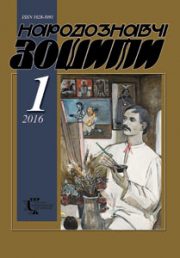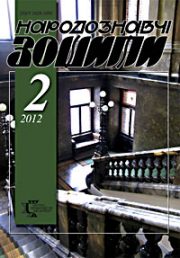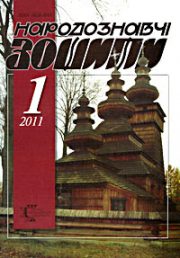The Ethnology Notebooks. 2025. № 3 (183), 537—545
UDK 093:76″16″-048.38
DOI https://doi.org/10.15407/nz2025.03.537
SHPAK Oksana
- ORCID ID: https://orcid.org/0000-0002-9719-4432;
- Candidate of Art Studies,
- Senior Researcher,
- Ethnology Institute of the National Academy of Sciences of Ukraine,
- Folk Art Department,
- 15, Svoboda Avenue, 79000, Lviv, Ukraine,
- Contacts: e-mail: shpak.oksana@gmail.com
Abstract. The copy of the incunabula «The Flowery Trio» (Krakow, printing house of Švajpolt Fiol, around 1493), which is kept in the Rare Book Department of the Vasyl Stefanyk National Scientific Library of Ukraine in Lviv, contains an equally rare example of a sheet of paper woodcut. On both flyleaves of the old print, two fragments of a large woodcut with images of saints and architecture, including details and inscriptions, have survived to the present time, glued to the frame during manufacture (or restoration).
The article’s purpose is to make a graphic (visual) and content reconstruction of the woodcut, hypothetically establish the general composition, list and iconography of the depicted saints, determine the probable center of manufacturing. The research relevance is due to the need to study little-known phenomena and items of Ukrainian art. During the work on the article, the methods of art historical analysis, comparison, and graphic reconstruction were used.
Based on the engraving preserved fragments, the general composition, as well as the list and iconography of the depicted saints, have been hypothetically established. The author substantiates the thesis about the probable center of manufacturing of this sheet engraving — the Kyiv-Pechersk Lavra Printing House on the basis of an analysis of the images` stylistics, the features of the saints’ iconography, and a comparison with contemporary book engravings. During the 17th century, the Kyiv-Pechersk Lavra Printing House ran off graphic sheets — copies of icons for pilgrims, sheets of moralistic content, and prayers. Such sheet woodcuts of the 17th century have a special stylistics: large-scale images, features of simplification and naivety, deliberate deformation of proportions, and decorative illumination with vermilion (cinnabar). The assumption of the Kyiv-Pechersk origin of the woodcut is also indirectly supported by the composition (the depiction of the silhouette of the church with domes as if «in section»), typical of Serbian and Greek engravings of the early 17th century.
Keywords: woodcut, engraving, Kyiv-Pechersk Lavra Printing House, introligation, iconography, incunabula.
Received 2.06.2025
REFERENCES
- Kachur, I. (2018). Incunabula Сollection of the Vasyl Stefanyk Lviv National Scientific Library: Provenance Review. Notes of the Vasyl Stefanyk Lviv National Scientific Library, 10 (26), 3—31. Retrieved from: file:///C:/Users/Ira/Downloads/lnnbyivs_2018_10_3.pdf [in Ukrainian].
- Svientsitska, V.I. (1965). Ukrainian Folk Engraving 17th—18th Centuries. Folk Art and Ethnography, 5, 47—50 [in Ukrainian].
- Krypiakevych, I.P., Lutsyk, R.Ya., & Maksymenko, F.P. (1971). Folk Engravings of the 17th Century. Ukrainian Art History, 5, 150—162 [in Ukrainian].
- Shpak, O. (2006). Ukrainian Folk Engraving of the 17th—19th Centuries. Lviv: Natsional’na akademiia nauk Ukrainy; Instytut narodoznavstva NAN Ukrainy [in Ukrainian].
- Shpak, O. (2017). Rare Folk Woodcuts from the Lviv Collections. The Ethnology Notebooks, 6 (138), 1615 [in Ukrainian].
- Kachur, І. (2020). Collection of Incunabula from the Vasyl Stefanyk National Scientific Library of Ukraine in Lviv: main provenancestock-keeping units, “From the Research on Books and Historical Book Collections”, (Vol. 14, pp. 213—233). Retrieved from: file:///C:/Users/Ira/AppData/Local/Temp/t_14_2_2_Kachur.pdf.
- Shpak, O. (2019). Endpapers of Cyrillic Manuscripts and Printed Books of the 15th—16th Centuries as a Source for the Study of Folk Woodcut (Based on Materials from the Collection of the Vasyl Stefanyk National Scientific Library of Ukraine). Preservation and Protection of Works of Art and Documents on Paper: Materials of the reports of the Second International Scientific and Practical Conference (Lviv, September 26—27, 2019). V. Stefanyk Lviv National Scientific Library of Ukraine; Ukrainian Academy of Printing (Pp. 175—187). Lviv: Firma «Kamula» [in Ukrainian].
- Bondar, N. (2013). Ostroh Cultural and Publishing Center in the Funds of the V.I. Vernadsky National Library of Ukraine. Scientific Notes National University «Ostroh Academy». Historical Sciences (Issue 13, pp. 393—412) [in Ukrainian].
- Hreshlyk, V. (2004). The Meeting of the Lord in the Village of Kozany near Bardiyev (A Few Notes on Its Icons, Iconostasis, and Wall Paintings and Engravings). Western Ukrainian Church Art. Materials from the international scientific conference. Lancut; Kotan. 17—18 April 2004 (Part II, pp. 319—325). Lancut [in Ukrainian].
- Aleksandrovych, V. (2008). Engraved Icons from the Collection of Volodymyr Vuitsyk in the Scientific Library Funds of the Ivan Franko National University of Lviv. Bulletin of Lviv University. Series: Bibliography, Library Science and Information Technologies (Issue 3, pp. 229—237) [in Ukrainian].
- Popov, P.M. (1927). Xylographic boards of the Lavra Museum (Issue 1). Kyiv [in Ukrainian].







